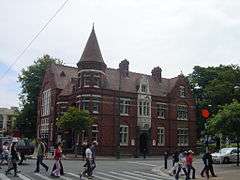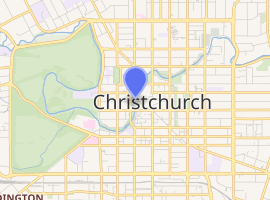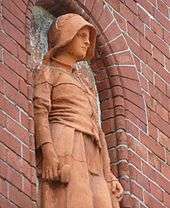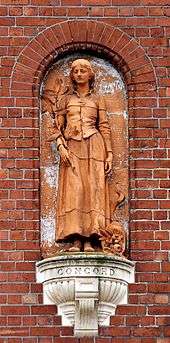Our City, Christchurch
Our City, more formally Our City O-Tautahi, also known as the Old Municipal Chambers,[1] is a Queen Anne style building on the corner of Worcester Street and Oxford Terrace in the Christchurch Central City. It is a Category I heritage building registered with Heritage New Zealand.[2] From 1887–1924 it was used by Christchurch City Council as their civic offices, providing room for meetings of the council and for housing staff, before they moved to the Civic. It was then used for many decades by the Canterbury Chamber of Commerce and served as the main tourist information. These days it is an exhibition and events centre.
| Our City O-Tautahi | |
|---|---|
 Our City in 2007 | |

| |
| Former names | Civic offices |
| General information | |
| Type | Former civic offices |
| Location | Christchurch Central City |
| Address | 159 Oxford Terrace |
| Town or city | Christchurch |
| Country | New Zealand |
| Coordinates | 43.5308°S 172.6336°E |
| Construction started | 1886 |
| Inaugurated | 24 March 1887 |
| Client | Christchurch City Council |
| Technical details | |
| Floor count | two |
| Design and construction | |
| Architect | Samuel Hurst Seager |
| Reference no. | 1844 |
| References | |
| "Municipal Chambers (Former)". Register of Historic Places. Heritage New Zealand. Retrieved 14 August 2018. | |
History

Civic offices
The Christchurch Municipal Council first met in 1862. Later that year, it became the Christchurch City Council. The council used Christchurch's first public building, the Christchurch Land Office, as their meeting venue and for housing council employees. The Land Office was built in 1851 on Oxford Terrace on the banks of the Avon River, just north of where the Worcester Street bridge crossed the river. The building had various public uses.[3] It was built on Reserve 10, which was a section of land reserved for public buildings.[4]
In 1879, the council administration had run out of room in the Land Office, and a competition for new civic offices and a town hall (i.e. a venue for large gatherings) for what is later known as Victoria Square was announced. After all the competition entries proved too expensive, the project was abandoned.[4]
Another competition was called for in 1885, this time for just civic offices (i.e. for a council meeting venue and for staff), and on the same site as the Land Office.[3] Controversy erupted when the competition was won by Samuel Hurst Seager; he was young and relatively inexperienced, and his design in Queen Anne style was an architectural type unfamiliar to New Zealand.[2] Construction began in 1886, but the controversy continued when councillor Samuel Paull Andrews claimed the building was structurally unsound. Benjamin Mountfort and John Whitelaw, both architects, and Edward Dobson, an engineer, reviewed the design and the building and found everything to be safe. The only suggestion they made was to strengthen the roof in a different, more costly way than designed by Seager.[2] The building was completed on 24 March 1887 and council met for the first time in their new premises on 4 April 1887.[3] The south façade of the building has two terracotta sculptures by George Frampton that represent 'Industry' and 'Concord'.[2]
In 1919, Council concluded that their premises were once again too cramped and started looking for an alternative. A bill was put to Parliament, seeking permission to extend the building to the north of Reserve 10 on land designated for public gardens or promenades,[5] but public opposition was too strong and the proposal was dropped.[6] Instead, Council purchased the burned out shell of the northern half of the Agricultural and Industrial Hall in 1920. Construction started in 1922, and the new offices, now known as the Civic, opened on 1 September 1924.[6] In 2010, council moved into their fifth civic office; to date, the Queen Anne design is the only purpose built civic offices in Christchurch.[3]
Other uses


Parliament passed a Christchurch Municipal Offices Leasing Act in 1922, which allowed council to lease the building that was situated on Reserve 10. The Canterbury Chamber of Commerce took the lease and held it until 1987. Part of the building was subleased to the Canterbury Promotion Council, later known as Christchurch and Canterbury Marketing, and they were in the building until October 2000.[4] Part of their function was to provide the main tourist information centre for Christchurch.
The building was taken over again by the council and opened as an exhibition, event and meeting space for the community in July 2002, branded as Our City O-Tautahi.[4][7] It is one of Christchurch's major tourist attractions.[8]
Earthquake damage
Our City was damaged in the 2010 Canterbury earthquake and was closed, with heavy bracing installed around the building.[9] The building is insured for NZ$5.8m, but repair options are in excess of that. One of the options has been estimated at NZ$10.5m.[10]
Heritage listing
On 2 April 1985, the building was registered by the New Zealand Historic Places Trust (now called Heritage New Zealand) as a Category I historic place, with the registration number being 1844. It is a rare example of the Queen Anne style, and at the time was a notable departure from the prevailing Gothic architecture. It was the first major commission for Seager and started his career. The building is a feature in its part of the city.[2]
References
| Wikimedia Commons has media related to Our City, Christchurch. |
- "Old Municipal Chambers (Our City O-Tautahi)". Christchurch City Council. Retrieved 14 August 2018.
- "Municipal Chambers (Former)". Register of Historic Places. Heritage New Zealand. Retrieved 13 August 2018.
- "Remembering our former homes as we move to the Council's new Home on Hereford". Christchurch City Council. Archived from the original on 7 August 2011. Retrieved 21 April 2011.
- "History". Christchurch City Council. Archived from the original on 26 January 2011. Retrieved 23 April 2011.
- Christchurch City Reserves Amendment Bill. 1919. NZLII: New Zealand Historical Bills. Retrieved 12 August 2018.
- "Christchurch City Council : Civic Offices" (PDF). Christchurch City Libraries. Retrieved 28 April 2011.
- "Our City O-Tautahi". Christchurch City Council. Retrieved 27 April 2011.
- "Our City O-Tautahi". Cultural Precinct. Retrieved 27 April 2011.
- "Staff at Christchurch City Council – Earthquake Update (Updated 14 September 2010)". Christchurch City Council. 14 September 2010. Archived from the original on 7 September 2010. Retrieved 27 April 2011.
- Cairns, Lois (3 April 2013). "Council quake study results due". The Press. Christchurch. p. A5. Retrieved 7 April 2013.